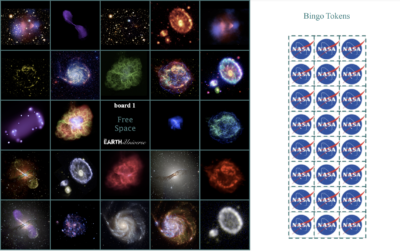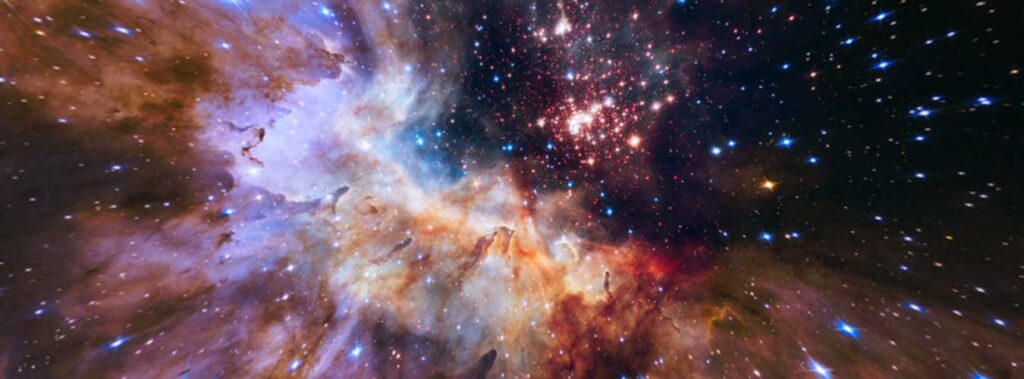Look Up! Featured Activity – Multiwavelength Bingo

Credit: Harvard Smithsonian Center for Astrophysics
This content was written by Christine Shupla from the Lunar and Planetary Institute
Celebrate the first images of NASA’s James Webb Space Telescope with this featured activity: Multiwavelength Bingo
Engage your patrons in astronomical images taken by telescopes studying the universe in different wavelengths in this game of bingo, after first exploring the idea of different types of light through an activity like Filtered Light or through this ViewSpace Interactive.
Facilitate as an in-person program at your library or as a Take & Make activity; interactive files are also available to conduct this game virtually with a group.
Time to complete: 20 minutes
Ages: 10 and up
Modification and Preparation List
Total Cost: $0 if printing is available; preferably print in color on cardstock. Ideally, laminate the cards and the bingo tokens.
Fundamental Space Science Concepts – Improv with the Stars relates to this Space Telescope’s First Images:
The James Webb Space Telescope is joining several other space telescopes that are studying the universe in different types of light. Each type of light, or wavelength, provides different information to astronomers, like different pieces of a puzzle.
Light comes in many different colors, or energies. We see some of these in a rainbow or a spectrum, with colors ranging from red through yellow and green, to blue and violet. There are other colors that our eyes cannot see: light that is less energetic and “redder” than red light is called infrared. Light that is more energetic and “bluer” than violet is called ultraviolet. There are also even more energetic forms of light, called x-rays and gamma-rays, and even lower energy light, called microwaves and radio waves.
Just like an x-ray can see inside your body to see your bones, the different energies of light can be used to explore various parts of our universe. The James Webb Space Telescope will be able to see into dense clouds to study new stars that are forming and will see some of the most distant galaxies whose light has shifted from visible to infrared with the expansion of the universe. It is joining NASA’s Hubble Space Telescope, which primarily examines visible and ultraviolet light, the Chandra X-Ray Observatory, and the Fermi Gamma-ray Space Telescope, along with x-ray and gamma ray telescopes operated by other countries.
Many of these types of light are partially or almost completely blocked by Earth’s atmosphere. To see the infrared universe more clearly (or to see the x-ray or gamma ray universe at all), NASA needs to place telescopes into space, above Earth’s atmosphere. These spacecraft are complemented by larger observatories on Earth’s surface.
Each observatory takes data that can be converted into an image using representative colors. These images may show information about supernova explosions and black holes, the locations of enormous jets of gas, and many other objects not easily studied in visible light. Together, these different types of telescopes provide a more complete picture of our universe.
Credit: NASA, ESA, CXC, SSC, and STScI
Resources for you to use and share with patrons:
Comparing the Hubble and James Webb Space Telescopes
This 5-minute video provides a comparison that includes details about how different wavelengths of light provide us with different details about the universe. It was produced by the European Space Agency, so all measurements are metric.
Infrared: Beyond the Visible
This 7½ minute video explores the electromagnetic spectrum and the different types of tools that can see those types of light not visible to human eyes, with a focus on infrared light and how it can help us understand the universe. Written at a level appropriate for most patrons.
See the Whirlpool Galaxy Through the Eyes of NASA’s ‘Great Observatories’
This fully captioned 3-minute video without audio describes how the Hubble and Spitzer Space Telescopes and Chandra X-ray Observatory have been used to study the Whirlpool Galaxy. Visible, Infrared and X-ray views of the galaxy reveal its amazing features. For older patrons (ages 10 and up) and adults.
Girls STEAM Ahead With NASA Program Cookbook
More detailed information about the different observatories and the light that they use, along with classroom activities, is available in this document by NASA’s Universe of Learning.
Discover more activities in the Look Up! First Image Clearinghouse Collection




Responses